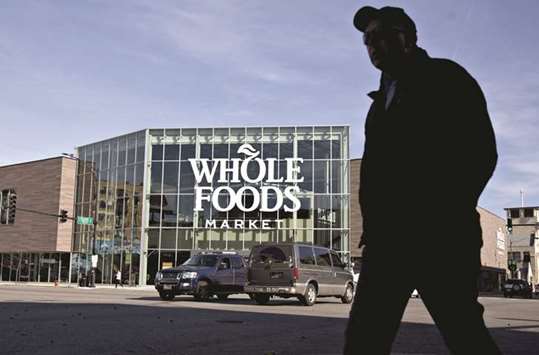US consumer spending slowed in October as the hurricane-related boost to motor vehicle purchases faded, while a sustained increase in underlying price pressures suggested that a recent disinflationary trend had probably run its course.
Other data yesterday showed a second straight weekly drop in first-time applications for unemployment benefits, pointing to a further tightening in labour market conditions that could soon generate faster wage growth and keep consumer spending supported, as well as push inflation higher.
The reports strengthened expectations that the Federal Reserve will raise interest rates next month.
The US central bank has increased borrowing costs twice this year.
“Today’s number should support the case of the hawks and centrists heading into the next Fed meeting in two weeks’ time,” said Michael Feroli, an economist at JPMorgan in New York.
The Commerce Department said consumer spending, which accounts for more than two-thirds of US economic activity, rose 0.3% last month after surging 0.9% in September.
Last month’s increase in consumer spending was in line with economists’ expectations.
The jump in spending in September was the largest since August 2009 and was spurred by some drivers in Texas and Florida replacing automobiles destroyed when Hurricanes Harvey and Irma slammed the states in late August and early September.
Spending on long-lasting goods like autos fell 0.1% last month after accelerating 2.9% in September.
Spending on non-durable goods such as prescription drugs and recreational items rose 0.2%. Outlays on services increased 0.3% amid a rise in airline tickets for foreign travel and communication services.
Though overall inflation subsided as disruptions to the supply chain following the hurricanes eased, underlying price pressures increased again at a steady clip in October.
The Fed’s preferred inflation measure, the personal consumption expenditures (PCE) price index excluding food and energy, rose 0.2% in October after a similar gain in September.
The so-called core PCE increased 1.4% in the 12 months through October, matching September’s rise.
The core PCE has undershot the Fed’s 2% target for nearly 5-1/2 years.
Fed Chair Janet Yellen told lawmakers on Wednesday that she believed the recent weak inflation readings likely reflected “transitory factors,” but also acknowledged the low inflation rates “could reflect something more persistent.”
“It looks like the worst is over for this latest idiosyncratic downdraft in core consumer inflation since the start of the year, and that Yellen was right to stick with her guns and maintain that low inflation is a transitory phenomenon,” said Chris Rupkey, chief economist at MUFG in New York.
The dollar fell against a basket of currencies, while prices for US Treasuries edged down. Stocks on Wall Street were trading higher, with the blue-chip Dow Jones industrial average index racing past the 24,000 mark for the first time.
With underlying inflation rising last month, so-called real consumer spending edged up 0.1% after increasing 0.5% in September.
The weak real consumer spending prompted economists to lower their fourth-quarter gross domestic product growth estimates by as much as two-tenths of a percentage point to as low as a 2.2% annualised rate.
Growth estimates for the fourth quarter have been lowered this week from around a 3% pace in the wake of data showing a large goods trade deficit in October and declines in wholesale and retail inventories.
The economy grew at a 3.3% rate in the third quarter, the fastest in three years.
Households are dipping into savings to maintain spending amid moderate wage growth.
Personal income rose 0.4% last month after advancing by the same margin in September.
Wages increased 0.3% last month following September’s 0.5% gain.
While savings climbed to $457.3bn last month from a more than nine-year low of $429.9bn in September, they remained well below levels seen early this year.
The saving rate increased to 3.2% after falling to 3.0% in September, which was the lowest since December 2007.
“The ‘savings dip’ will limit the upside to consumer spending growth in the fourth quarter,” said Gregory Daco, chief US economist at Oxford Economics in New York.
There are, however, expectations that wage growth will accelerate as the labor market tightens further.
In a separate report yesterday, the Labor Department said initial claims for state unemployment benefits slipped 2,000 to a seasonally adjusted 238,000 for the week ended November 25.
Last week marked the 143rd consecutive week that claims remained below the 300,000 threshold, which is associated with a strong labour market.
That is the longest such stretch since 1970, when the labour market was smaller.
The labor market is near full employment, with the jobless rate at a 17-year low of 4.1%.

A pedestrian passes in front of the Lakeview Whole Foods Market store in Chicago. The Commerce Department said consumer spending, which accounts for more than two-thirds of US economic activity, rose 0.3% last month after surging 0.9% in September.


